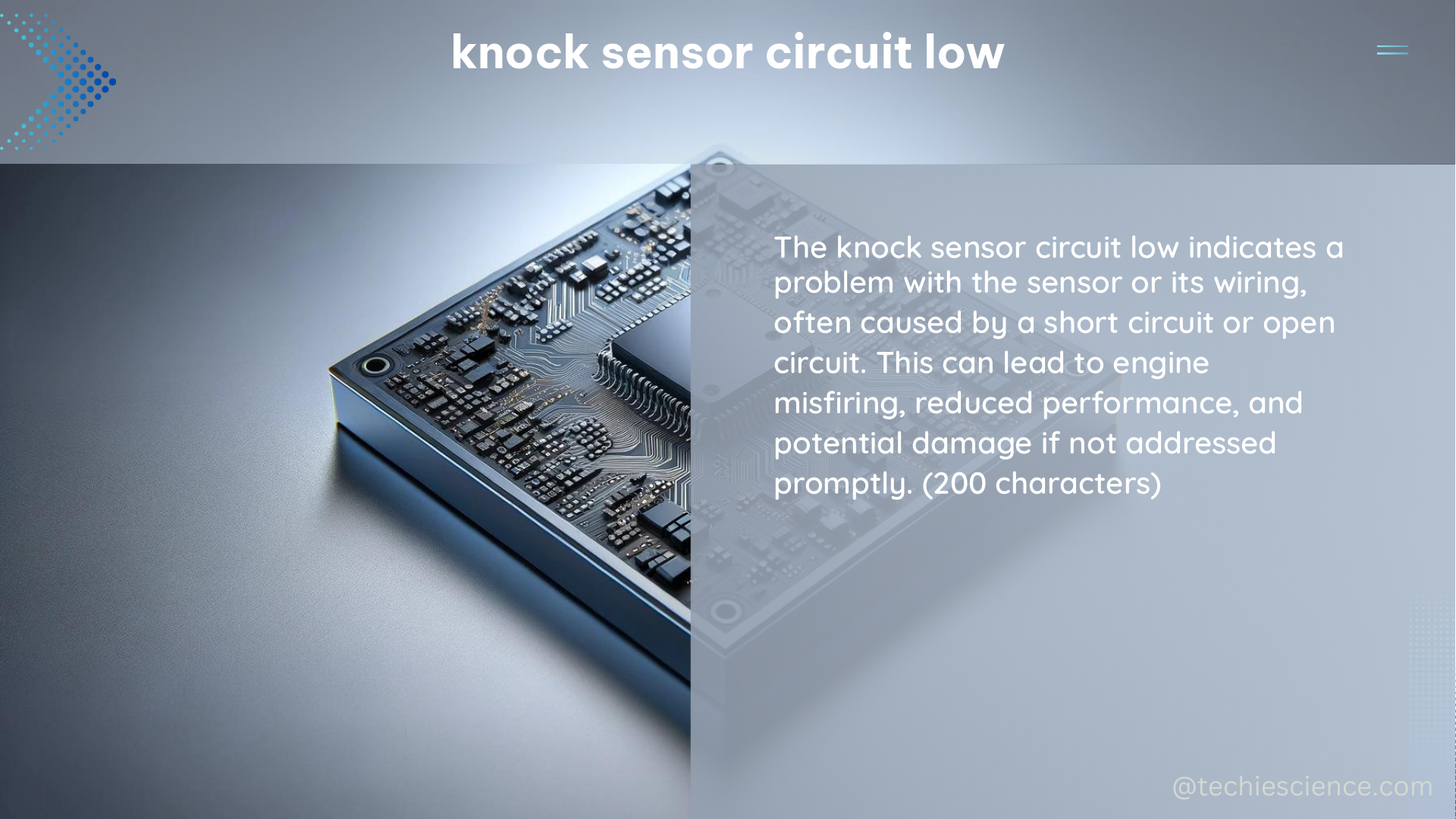The knock sensor circuit low issue, often indicated by a P0327 code, is a common problem in vehicles. This issue arises when the PCM (Powertrain Control Module) detects low voltage readings from the vehicle’s primary knock sensor circuit. The knock sensor plays a crucial role in detecting vibrations or irregularities in combustion and sending a signal to the engine control computer, which then adjusts the timing to correct the knock.
Understanding Knock Sensor Circuit Low
When a knock sensor low voltage code appears, it may cause the ECM (Engine Control Module) to pull timing as a safety measure to prevent engine damage due to excessive knocking or irregular combustion. However, the specific voltage threshold at which the ECM pulls timing can vary depending on the vehicle make and model.
The knock sensor circuit is designed to operate within a specific voltage range, typically between 0.5V and 4.5V. If the voltage reading falls outside this range, the PCM will detect a low voltage condition and set a P0327 code.
Diagnosing Knock Sensor Circuit Low

To diagnose and fix a P0327 code, it’s essential to follow a systematic approach:
1. Locate the Knock Sensor(s)
Consult the vehicle’s service manual or online resources to find the exact location of the knock sensor(s) on your engine. This information is crucial for accessing the sensor and checking the wiring.
2. Check the Wiring
Inspect the wiring for any signs of damage, open circuits, or shorts. Make sure all connections are secure and free from corrosion. Use a multimeter to measure the resistance of the wiring, which should be within the manufacturer’s specified range, usually between 1-5 ohms.
3. Test the Knock Sensor
If the wiring appears to be in good condition, use a multimeter to test the sensor for continuity and resistance. The sensor should have a resistance value within the manufacturer’s specified range, typically between 1-5 kΩ.
4. Replace the Knock Sensor
If the sensor fails the tests, replace it with a new one compatible with your vehicle make and model. Ensure that the replacement sensor is properly installed and secured.
5. Clear the Code and Verify
After replacing the sensor, use a scan tool to clear the P0327 code and verify that it doesn’t return after driving the vehicle. If the code reappears, there may be an underlying issue with the ECM or other related components.
Technical Specifications
Here are some key technical specifications related to the knock sensor circuit:
| Specification | Typical Range |
|---|---|
| Knock Sensor Voltage | 0.5V to 4.5V |
| Wiring Resistance | 1-5 ohms |
| Sensor Resistance | 1-5 kΩ |
It’s important to note that these values may vary depending on the vehicle make, model, and year, so always refer to the manufacturer’s specifications for your particular vehicle.
Troubleshooting Tips
- If the wiring and sensor tests are within the expected ranges, the issue may be with the ECM. In rare cases, a faulty ECM can cause a P0327 code.
- Ensure that the knock sensor is properly grounded and that the ground connection is not compromised.
- Check for any other related codes that may indicate a broader issue with the engine or fuel system.
- Consider the vehicle’s mileage and service history, as older or high-mileage vehicles may be more prone to knock sensor-related problems.
Conclusion
The knock sensor circuit low issue can be a frustrating problem, but by following a systematic diagnostic approach and understanding the technical specifications, you can effectively troubleshoot and resolve the issue. Remember to always consult the manufacturer’s guidelines and use the appropriate tools and equipment to ensure a safe and successful repair.
References
- Knock Sensor Low Voltage Code Cause Timing Pulled
- Knock Sensor Low Input Voltage Bank 2
- P0327 Knock Sensor 1 Circuit Low Input Bank 1 or Single Sensor
- SES Light Due to Knock Sensor Low Input
- Knock Sensor Low Voltage Troubleshooting

The lambdageeks.com Core SME Team is a group of experienced subject matter experts from diverse scientific and technical fields including Physics, Chemistry, Technology,Electronics & Electrical Engineering, Automotive, Mechanical Engineering. Our team collaborates to create high-quality, well-researched articles on a wide range of science and technology topics for the lambdageeks.com website.
All Our Senior SME are having more than 7 Years of experience in the respective fields . They are either Working Industry Professionals or assocaited With different Universities. Refer Our Authors Page to get to know About our Core SMEs.